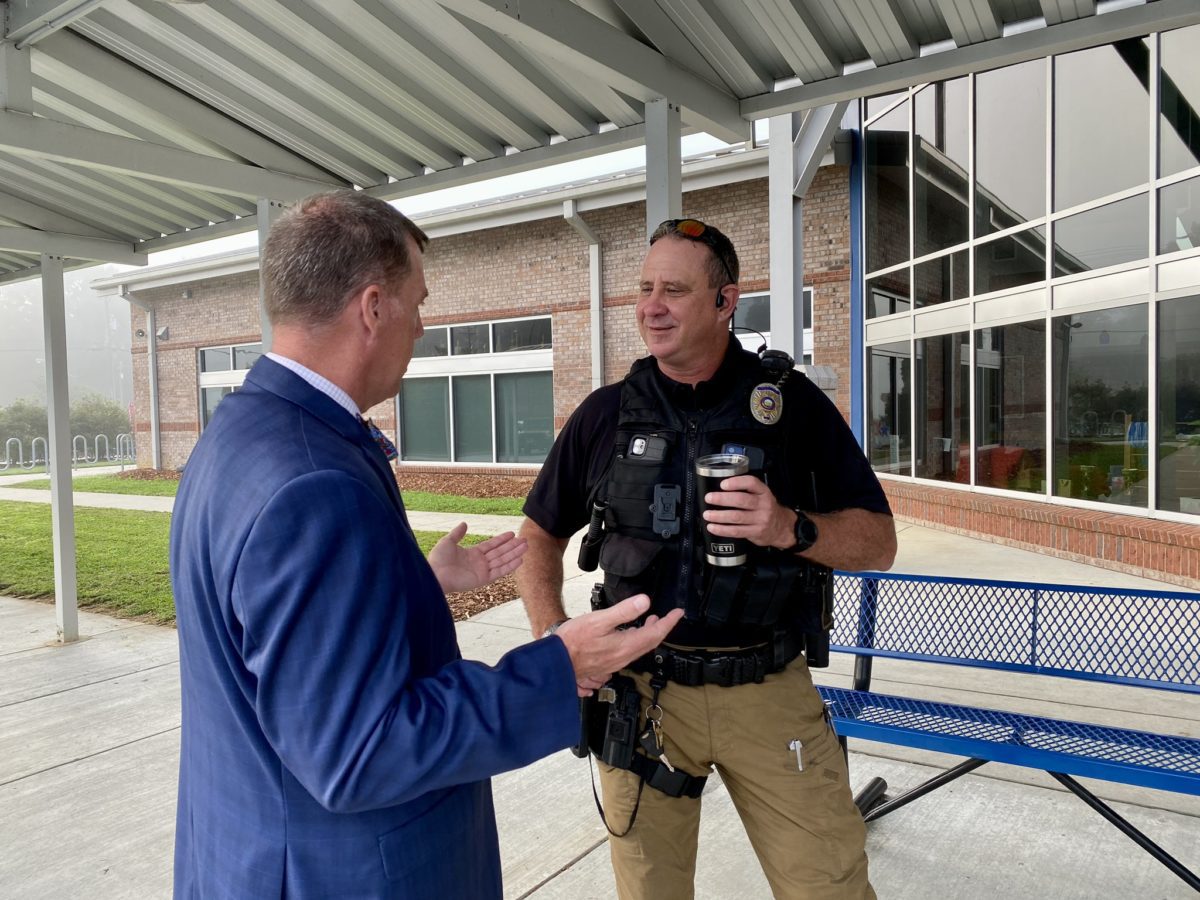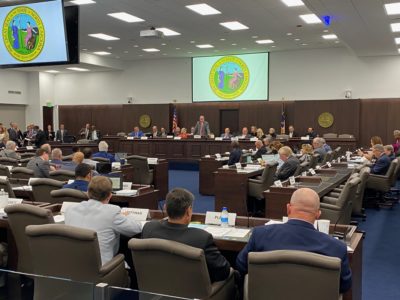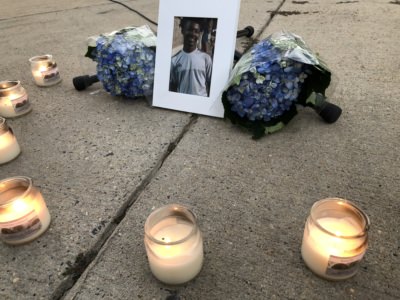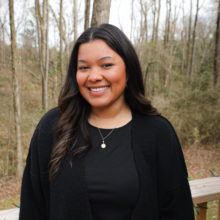
Share this story
In the wake of incidents of school violence in the state and around the country, schools across North Carolina have reassessed their safety and security measures.
Some schools began their school safety initiatives this summer by meeting with parents, hosting online calls, and implementing additional measures. For most, these safety measures were implemented during the first week back to school.
Counties are taking a variety of approaches. From adding additional school resource officers (SROs) to implementing new emergency alert systems, here’s a look at how four different school districts are preparing for the new school year.
School resource officers
According to the National Association of School Resource Officers, an SRO is “a carefully selected, specifically trained, and properly equipped full-time law enforcement officer with sworn law enforcement authority, trained in school-based law enforcement and crisis response, assigned by the employing law enforcement agency to work in the school using community-oriented policing concepts.”
According to the National Association of State Boards of Education, any North Carolina officer assigned as a SRO starting in January 2020 must complete a School Resource Officer Training course within one year of being assigned as an SRO.
According to EdWeek, about 91% of SROs are armed, with most also carrying other restraints like handcuffs.
The state legislature allocated more money for SROs this year. This includes putting $32 million into the School Safety Grant program, including money for school safety training and safety equipment in schools. The legislature also added $15 million for the School Resource Officer Grant program. Another $26 million will go to an allotment to help districts provide one SRO for each high school.
The Public Schools of Robeson County (PSRC) is one district implementing changes. This fall, each school will have an SRO or a shared SRO. According to Bobby Locklear, the assistant superintendent of auxiliary services, PSRC is making efforts to increase the number of SROs in its district, even though there will not be a dedicated SRO at every school.
“With the addition of all the officers, what we decided to do was assign officers based on the affinity of schools,” Locklear said.
This means that, even though some schools will not have an SRO for the entire day, an officer will always be in close proximity to the school.
Other districts like Alamance-Burlington School System have made efforts to ensure that each school has an SRO. According to district Public Information Officer Les Atkins, in the past, some schools only had part-time staff, while others had full-time officers.
“That was really a priority this year – to put them in every school. So the board earmarked $2.7 million to do that,” Atkins said. He said the district’s board utilized partnerships with local departments, including the Alamance County Sheriff’s Department, Graham Police Department, Burlington Police Department, and others.
These SROs will be paid from school funds, but the respective law enforcement agency will provide equipment. At the start of school last week, each Alamance-Burlington school had its own SRO – except for the district’s virtual school and its early college, which is housed at Alamance Community College and is provided with security there.
Other safety measures at ABSS include security vestibules, additional cameras, and more. Security vestibules provide a secure area when visitors enter and check in with the front office. Typically, there are sets of doors that remain locked, so visitors’ only access to the school is through the office. Atkins says these will provide an extra layer of protection when visitors enter the school.
Taking the conversation online
Union County Public Schools (UCPS) hosted a safety and security update on its Facebook on Aug. 16 – about two weeks before the start of school. The live stream has received over 7,000 views, with hundreds of parents and Union County residents engaging in the comments.
In the live stream, UCPS updated parents on its process for making safety and security decisions. UCPS staff encouraged parents and students to submit tips on its tip line and Say Something – an anonymous reporting line. UCPS is one of many districts adding additional SROs to its district. Each middle and high school will have a dedicated SRO. There will be one SRO dedicated to two elementary schools in the district, as well.
UCPS received several questions in the comments from parents. Questions included:
- Should teachers be barricading doors and hiding students or evacuating students during an active shooter situation?
- Will the school district allow armed volunteers (such as veterans) on campus for additional security?
- Are principals and administrators actively checking to ensure that exterior doors remain locked?
UCPS answered these questions and others during the live stream. The district said that SROs and school staff are trained to “run, hide, or fight,” in the event of an active shooter situation. This means if an active shooter event were to occur, staff must determine what action to take by using the Run-Hide-Fight model.
Assistant Superintendent of Student Support Jarrod McCraw said volunteers are not authorized to be armed on school grounds. However, he encouraged those interested in volunteering to do so in other ways.
Sign up for the EdWeekly, a Friday roundup of the most important education news of the week.
A softer approach to school safety
In addition to hiring additional SROs and purchasing new safety equipment, some schools are taking softer approaches to the issue of school safety.
In its live stream, UCPS also discussed the importance of mental wellness and safety for students. Kasha Giddins, director of student support, said offering a “multi-tiered system of support” to students through school counselors, social workers, and a partnership with the local health department that provides mental health therapists. Giddins shared that there will also be teletherapy available this fall for UCPS high school students.
“We know the years of COVID, there’s been more trauma that’s been appearing in our buildings, and so we want to be able to provide this multi-layer support for the students so that they can get the help they need, so they could be more productive while they’re in school,” Giddins said.
Atkins said the ABSS is taking on a $90,000 project to complete a crime prevention through environmental design safety study at all of its schools to determine what additional safety measures are needed.
In 2019, PSRC developed a mental health team to help the district spot any signs of students who may need additional support. Jadell Dial Hawks, the district’s director of student services, said they have been able to identify student needs early on.
“We definitely have been able to find out and identify children early and have an early warning system about things and understand what needs to be in place for families to safeguard them,” Hawks said.
Prioritizing preparation and partnerships
Dr. Jason Atkinson, Bladen County Schools superintendent, said increasing training and strengthening security measures is a top priority. He said increasing safety also means considering how human behavior impacts safety.
Atkinson said Bladen will be increasing its number of cameras and metal detectors on campus, and completing additional bag checks. The Bladen County Sheriff’s Department completed additional active shooter training at Bladen Lakes Primary School and West Bladen High School this summer.
Bladen County has approved SROs for every Bladen county school, but there are not enough available law enforcement officers to fill these roles. SROs will continue rotating at these schools until more SROs are hired.
Atkinson said increased preparedness through additional training and building relationships with the community is a part of improving safety and security. Atkinson emphasized that continuously reevaluating its procedures and drills will help his school increase its preparedness. He also emphasized the importance of involving the local community in its preparations.
“We’ve got to continue to practice and evaluate how we’re doing things and obviously, anytime you deal with safety, it becomes a community concern,” Atkinson said.
Atkinson said churches and local businesses act as destination or evacuation points during emergencies, so including them in the district’s preparation plans is important.
Seeing SROs as a resource
Districts are emphasizing the need for SROs to increase visibility on campus – one major benefit of having a dedicated SRO at schools.
Atkinson said it’s important that students know SROs are there to benefit them.
“I have a greater sense of security, knowing the safety measures we put in place and knowing that we have officers that are there to help with the safety of the campus, but also with the training and help build those relationships,” Atkinson said. “It’s not just about having a voice for security, but their presence and that positive role model for students is important.”
Atkins shared a similar sentiment. He said creating relationships with students is how SROs and school administrators can detect warning signs.
“Their role is really to build relationships with students. So you’ll likely see an officer out in the morning in the car line, you know, greeting students. They may be opening the door, they may say hello to family members to get to know them, and the purpose of that is so that they build that rapport with students,” Atkins said.
Deputy Chris Byram with the Union County Sheriff’s Office is an SRO at Weddington High School. He says SROs developing a strong relationship with students allows students to feel a sense of security.
“Encourage your child to not only get to know who your school resource officer is and develop that relationship with a school resource officer,” he said. “They can go to someone that they trust, someone that they can buy into.”
Recommended reading



